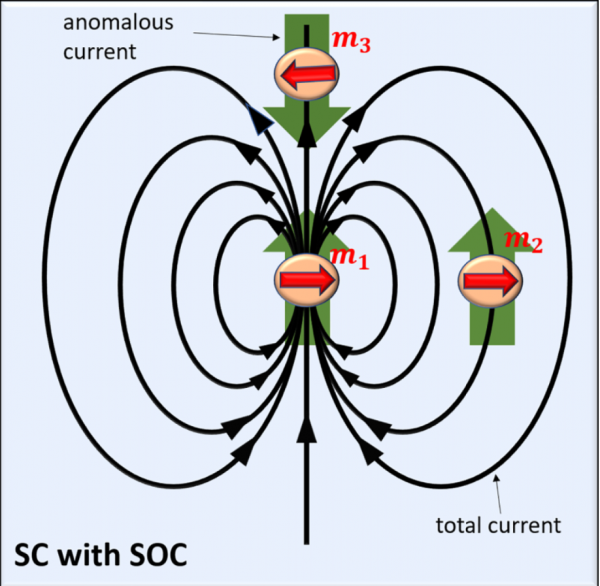Ferromagnetic ordering of magnetic impurities mediated by supercurrents in the presence of spin-orbit coupling
Usually conventional superconductivity and ferromagnetic ordering are considered antagonistic effects. In contrast to this conventional understanding, our study reveals long-range ferromagnetic interactions between magnetic impurities in superconductors with spin-orbit when taking into account the influence of the electromagnetic field.
Ferromagnetic ordering is often seen as in- compatible with conventional superconductivity due to the presence of an effective exchange field in ferromagnets. This exchange field has the effect of breaking up Cooper pairs, which are composed of electrons in a singlet state. The coexistence of these two orders, however, does exist in hybrid superconductor/ferromagnet (S/F) structures. In ferromagnet/superconductor/ferromagnet (F/S/F) structures, the energetically favorable arrangement is an antiparallel orientation of the magnetizations of the two F regions. This situation changes in thin superconducting films with spin-orbit coupling (SOC). The combination of the exchange field generated by a magnetic impurity ( m1 in Figure 1) and the SOC results in the spontaneous generation of anomalous currents through the spin-galvanic effect. In the case of a Rashba SOC, they flow perpendicular to the magnetization. The orientation of th3 magnetic moment of a second impurity (m2 and m3 in Figure 1) is determined by minimization of the free energy: To reduce the kinetic energy of the superflow they will generate anomalous currents that suppress the currents induced by m1. Consequently, m2 will point in the positive x direction and m3 to the negative x direction. In other words, the supercurrent mediated magnetic interaction is ferromagnetic between m1 and m2 while it is antiferromagnetic for m1 and m3. Previous studies on Rashba superconductors have obtained an interaction resembling the 2D DDI form, which does not result in either a ferromagnetic or an antiferromagnetic ground state for two impurities. However, those studies have neglected the influence of the electromagnetic (EM) field.

Figure 1: Schematic plot of magnetic impurities on top of a superconductor thin film with spin-orbit coupling. The red arrows represent the magnetization of the impurities. The green arrows are the exchange field-induced localized anomalous currents. The black loop represents the total current induced by the exchange field, phase gradient, and electromagnetic field.
In this work, we present a theory elucidating the impact of the electromagnetic field on the magnetic coupling between impurities. We predict a ferromagnetic coupling between two impurities in superconducting systems with SOC. In a Bravais lattice (Figure 2) of magnetic impurities, superconductivity mediates the establishment of ferromagnetic order within specific parameter ranges. These findings challenge the conventional understanding that ferromagnetism and superconductivity are mutually exclusive phenomena. Our theoretical framework provides a plausible explanation for the recently observed remanent flux and transport signature of ferromagnetism in iron-based superconductors, particularly Fe(Se,Te).

Figure 2: (a), (b) Schematic picture of the ferromagnetic and the layered antiferromagnetic states of a Bravais magnetic impurity lat- tice. (c) Temperature dependence of the interaction strength. The red line and blue line denote parallel and perpendicular coupling respectively. (d) Phase diagram for a 2D impurity lattice.



